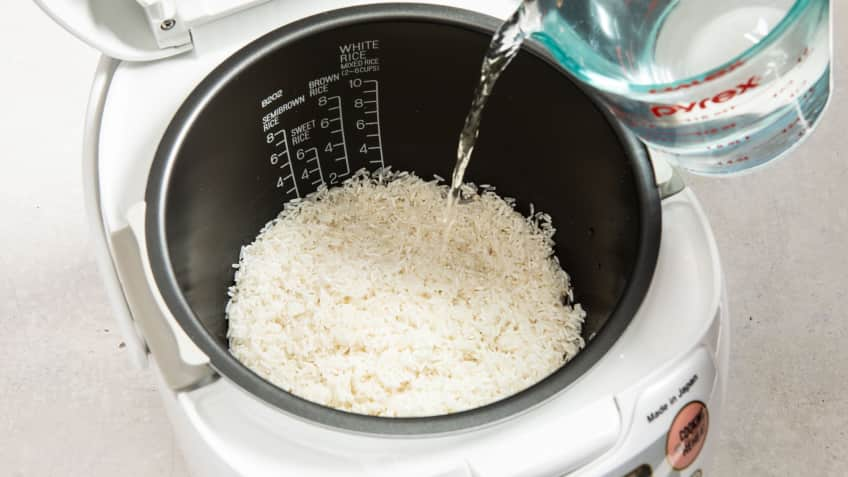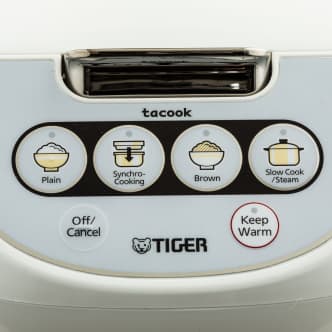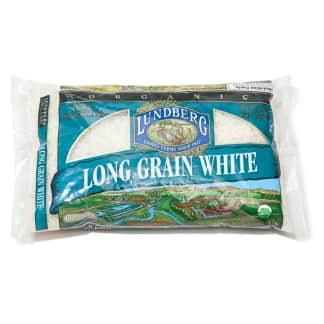The best rice cookers consistently prepare multiple varieties of rice well with the push of a button. We found two models that make exceptional rice and are also easy to use and clean. The Zojirushi 5.5-Cup Neuro Fuzzy Rice Cooker & Warmer is our top performer, followed closely by the Toshiba 6-Cup Rice Cooker with Fuzzy Logic. They both have clearly labeled measurement lines inside their cooking bowls and audible alerts that signal when they have finished cooking and switched to their keep-warm settings. And since both machines have removable inner lids and slick nonstick-coated cooking bowls, they are a breeze to clean. The Zojirushi came out on top due to the convenient plastic handles on either side of its cooking bowl, which protected our hands from the heat when scooping cooked rice.
You can make rice on the stovetop (or in the oven), but there are advantages to using a rice cooker: The process is mostly hands-off and yields consistent results from batch to batch. Plus, a rice cooker can keep cooked rice warm for hours without sacrificing quality. Rice cookers were developed for home use in Japan in the 1950s. Prior to that, Japanese home cooks used a centuries-old technique of preparing rice in either a cast-iron hagama or an earthenware donabe on a kamado (wood-burning stove). The electric rice cooker automated and simplified this time- and labor-intensive process first in Japan and then around the world.
The Rice Cooker That Changed My Mind About Rice Cookers
Compact yet versatile and reliable, this intelligent rice cooker has transformed my weeknight cooking.So how do rice cookers work? There are two main ways. Most electric rice cookers use a hot plate (a resistive heating element) located beneath the cooking bowl to generate heat; the heat then travels through the cooking bowl to the food. But some modern cookers use induction heating, a different technology that causes the bowl to heat up directly by subjecting it to an electromagnetic field. Either way, the water in the bowl heats up, the rice absorbs the water as it cooks, and steam escapes through a vent in the top of the machine. A sensor inside the machine registers when the temperature rises above 212 degrees—the highest temperature water can reach when not heated under pressure, indicating to the machine that all the liquid has been absorbed or evaporated. Every model in our lineup automatically switches to a “keep warm” setting when the rice is done cooking.

We’re happy to report that most of these machines made acceptable rice the very first time we used them, though some machines initially produced wetter rice than others. Rice cookers are designed to take the guesswork out of making rice, but there was a learning curve with certain machines. With some small adjustments to the ratio of rice to water, we were able to cook rice to our preferences in most of the machines. What differentiated these machines more was their ease of use.
Some models we tested were very simple to operate: After rinsing the rice, we measured it and added it along with the corresponding amount of water to the cooking bowl and then just flipped a switch to start the cooking process. Other models had several settings for different types of rice and styles of cooked rice dishes. Some of these more advanced models employ "fuzzy logic" technology that adjusts the time and temperature as the rice cooks in order to get the best results.
Some of the rice cookers in our lineup include a soaking phase at the beginning of the cooking process and a steaming step at the end of it to purportedly improve the texture of the cooked rice. To find out which models actually performed these functions and how long they took, we monitored the temperature inside each rice cooker throughout their cooking cycles. While our tests didn't produce any definitive data confirming the existence of these stages, we did discover that those with lower temperatures at the start of cooking and longer cooking periods produced the best rice. The fastest cookers made large batches of long-grain white rice in about 30 minutes, while the longest cookers took about 65 minutes. Here, speed wasn’t an advantage; we found the quality of the rice to be superior in the machines with longer cooking cycles.
What To Look For
- Longer, Slower Cooking Times: Rice cookers with longer cooking cycles produced better results than those with shorter cycles. The machines that kept their water temperatures low during the first few minutes of cooking (an indication of an initial soaking step) produced rice that was evenly cooked through (no blown-out grains); the grains also retained a nice chewy texture.


- Clearly Labeled Measuring Lines: It’s crucial to use the right ratio of water to rice to achieve well-cooked rice, so we liked the models that had clearly marked water measurement lines on their cooking bowls. Since all the bowls of the models we tested were dark-colored, those with white measurement lines were the easiest to read.

- Intuitive and Clearly Labeled Displays: Two of the simplest rice cookers had just an “on” switch, but even the machines with several more cooking options were easy to use if the operating displays were clearly labeled.


- Digital Countdown Timers and Audible Alerts: We liked models with timers. Some began as soon as we pressed "start,” while others started when there was 10 to 15 minutes left in their cooking cycles. We also liked machines with audible alerts that let us know when our rice was done.
- Removable Inner Lid: As the rice cooked, starch collected on the undersides of the machines’ lids. We preferred models with removable lid inserts or with lids that could be removed entirely because they were easier to wash and dry thoroughly.
Nice to Have
- Handles: Plastic handles on either side of a cooking bowl allowed us to easily remove it from the machine, even when the bowl was hot. Handles also made portioning rice easier because we could hold the bowl with one hand and scoop with the other.
What To Avoid
- Hard-to-Read Measurement Lines: Cooking bowls with stamped or raised measurement lines were difficult to decipher. We had to move our heads around to catch a glimpse of these lines when the lighting was right.
- Machines That Cook Hot and Fast: Machines that quickly heated the water and cooked the rice for shorter periods of time produced rice that consistently ranked lower than rice made in machines that cooked it more slowly. This was especially true in our brown rice tests.

- Hard-to-Clean Machines: One machine lacked a detachable lid insert, and it was difficult to wash and rinse it while it was still attached to the body of the rice cooker. With a few models, starchy water escaped through the steam vent cap or hole in the rice cooker's lid, leaving a bit more for us to clean up. We noticed starchy water leaking from the side of another machine.

Other Considerations
- Trial and Error with Ratios Can Be Expected in Many Models: Some rice cookers provide standard water-to-rice ratios for all types of rice, while others require more water for certain varieties of rice. With most machines, the ratios for long-grain white rice to water worked perfectly the first time we tried them. But when we used the recommended ratios for medium-grain brown rice, the resulting rice was often too wet. We preferred using the amount of water required for making long-grain white rice when making brown rice.
- Induction Cooking: Induction rice cookers are often more expensive than traditional electric rice cookers, and in our tests, they didn't consistently perform better or faster, either.
• Cook a small batch of long-grain white rice
• Cook a large batch of long-grain white rice
• Cook a half-capacity batch of short-grain white rice
• Keep short-grain white rice rice warm for 2 hours
• Cook 2 cups of medium-grain brown rice
• Cook a half-capacity batch of long-grain white rice with a data logger inside to track the temperature of the rice and water during cooking
• Top three models only: Test the quick-cooking setting with long-grain white rice and test the “keep warm” setting for 12 hours with medium-grain brown rice
• Wash inner lids or glass lids after every test
• Wash all cooking bowls with soap and water after every test


























